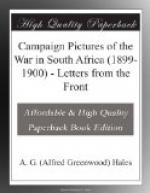The Boers know him now as the prince of rifle shots and the king of scouts. He is standing in the wintry sunlight just in front of my tent as I am writing, one hand on the bridle of his horse, rapping out Dutch oaths with a strong Cork accent to a nigger who has not groomed his pet animal properly. The nigger is very meek, for past experience has told him that Irish blood is hot, and an Irishman’s boot quick and heavy. He is a picturesque figure, this Celtic scout leader, just such a picture as Phil May could bring to life on a sheet of paper with a few strokes of his master hand. He is about eleven stone in weight, and, roughly, five feet eight, clean cut and strong, with a face which tells you he was born in Cork, and had knocked about a lot in tropic lands; eight-and-thirty if he is a day, though he swears at night around the camp fire that the pretty Dutch girls have guessed his age as twenty-seven. He wears a slouch hat, around which a green puggaree coils lovingly. In his right hand his rifle rests as if it felt at home there. His coat is worn and shabby, khaki in colour; riding pants of roughest yellow cords, patched in places unspeakable, leggings around his sinewy calves, and feet planted in neat boots make up the whole man. He is clean shaven except for a moustache, dark brown in colour, which sprouts from his upper lip.
In his softer moments Driscoll tells us that it used to “cur-r-r-l” before he had the “faver” in Burmah, and on such occasions we assure him that it “cur-r-rls” even yet. It is more polite to agree with him than to cross him—and a lot safer. He is as full of anecdote as heaven is of angels, and I mean to use him in the sweet days of peace, unless some stay-at-home journalist niches him from me in the meantime. Driscoll and Davies are fast friends. The Englishman is not such a picturesque figure as the Irishman. Englishmen seldom are, somehow; but he is a man, a real white man, all over. He is rather a good-looking, well set-up young fellow, who always looks as if he had just had a bath; not a dude by any manner of means, but a fellow with a soft eye for a pretty ankle, and a hard fist for a foe—one of those quiet chaps a man always likes to find close beside him in a row. Driscoll almost weeps over him to me sometimes. “He’s the devil’s own at close quarters,” says the Irishman. “Never want a better chum when it comes to bashing the enemy. If he could only shoot a bit ’straighther and talk a bit sweether to the colleens he’d be perfect.” All the same, I have, and hold, my own opinion concerning the “talking.” Many a smile which the gallant Celt appropriated to himself as we rode out of a conquered town seemed to me to belong of right to the rosy-faced Welsh lad on the off-side. To hear these two men chatter over a glass of hot rum in my tent at night one would think they had never faced danger. Yet never a day goes by but one or the other of them has to run the gauntlet of Boer rifles; whilst Jack Brabant, who is death on cigars or anything else that will emit smoke, and who curls up and says little, has been near death so often that it will be no stranger to him when it comes in all its finality.




